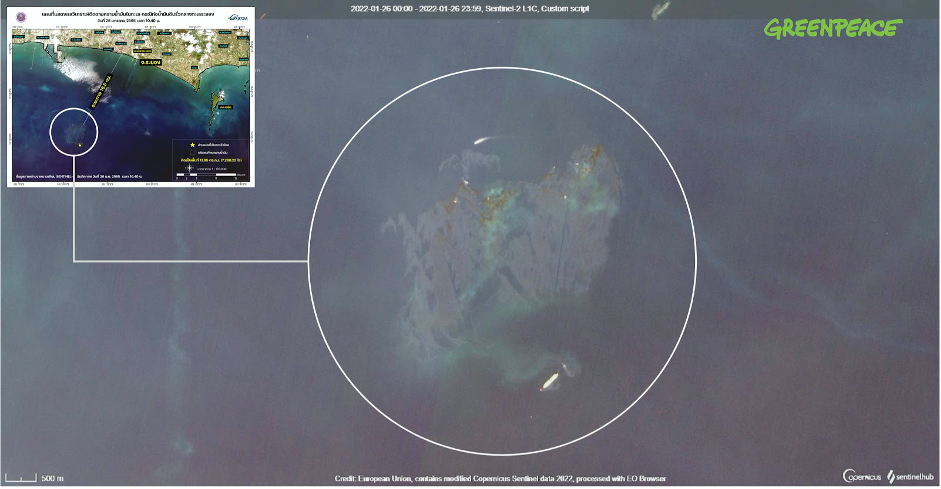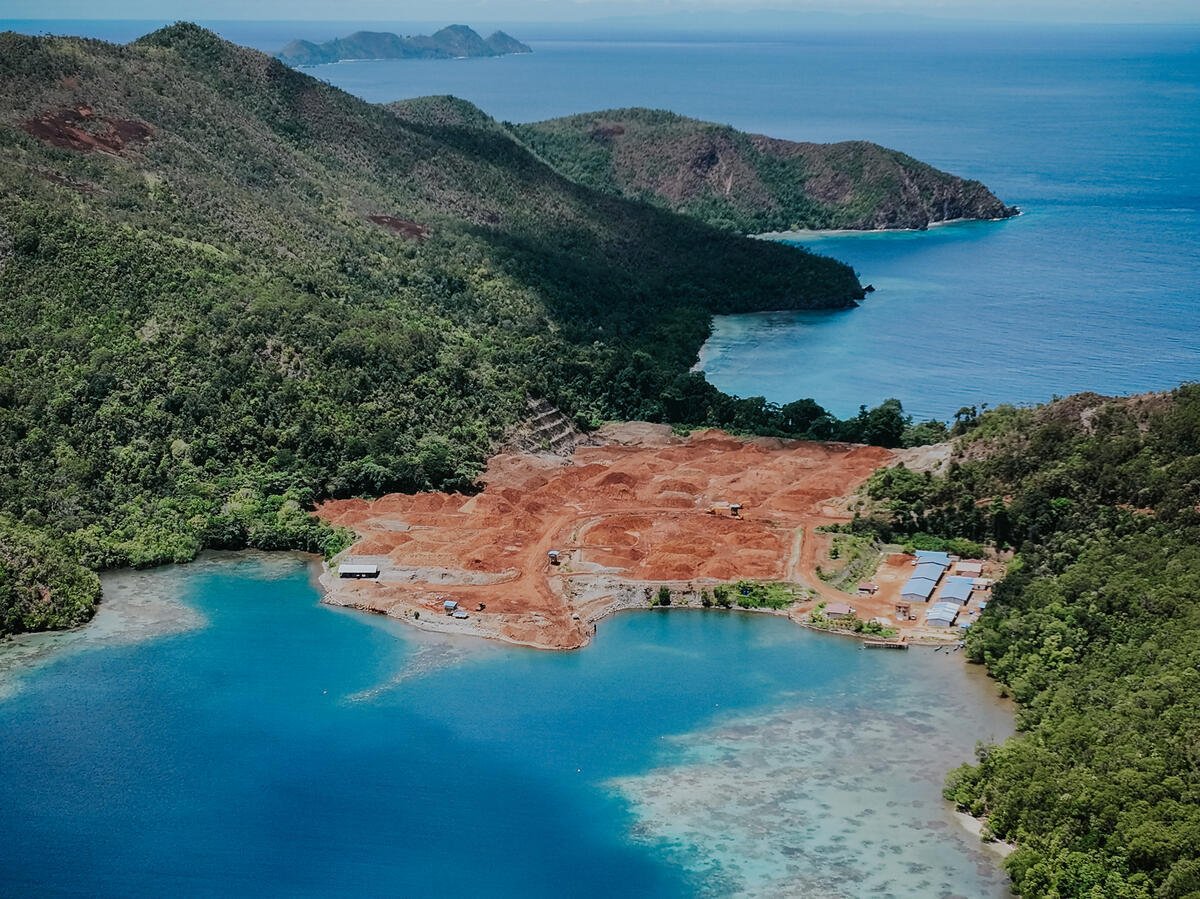Cover-ups, lies and negligence— these were what we discovered in the aftermath of the recent oil spill and marine pollution in Thailand’s Rayong province where the fossil fuel industry managed to seize both economic and political power in recent years.
On the night of January 25, 2022, an underwater crude oil pipeline was reported to be leaking at an offshore oil transfer point about 20 kilometers southeast of the Map Ta Phut port and industrial estate. The pipeline belonged to Chevron-owned Star Petroleum Refining Public Company Limited (SPRC). The incident resulted in a massive oil spill that has since blackened our waters and beaches, now threatening local wildlife and communities reliant on the sea.

Earlier on the 25th, an analysis by the Geo-Informatics and Space Technology Development Agency (GISTDA), using images from the Sentinel-2 satellite, discovered the oil spill covering an area of 11.65 square kilometers- more than twice the size of Koh Samet, the main tourist island in Khao Laemya marine national park.
On January 28th, SPRC issued a statement saying that no oil slick was discovered on beaches even as the oil floated away from the spill site. That same day, GISTDA monitoring showed how the oil slick grew to 16 sq. kilometers in size and moved towards the Mae Ramphueng beach. The next day, the crude oil slick was seen on Mae Ramphueng beach, disrupting tourism and putting a stop to local fishing activities.
Thai seas in peril
Thais are proud of the fact that our seas remain one of the world’s richest food sources and yet we always take it for granted as recent history has shown.
Oil spills and other forms of marine pollution regularly occur along oil transportation routes where oil tankers load and offload and where petroleum companies operate, particularly in the Gulf of Thailand. Since 1974, there have been at least 240 oil spill incidents in Thai waters. Information on these incidents are often incomplete.

Source: Water Management Bureau of the Pollution Control Department 2011. Credit: Bangkok Post Graphic
Murky waters
From the start, information provided by the SPRC and other government agencies— including the Minister of Industry, Mr. Suriya Jungrungruangkit— were ambiguous and inconsistent, particularly on the amount of crude oil that leaked.
According to Mr. Jungrungruangkit, the initial estimate of the oil leak was at 400,000 liters. SPRC came up with the figure on the first night it discovered the leak. The morning after, the leak was found to be 160,000 liters. A dive team from SPRC was then sent to the scene and, afterwards, estimated the leak to be 50,000 liters.
The Minister of Industry then went on to say that the oil slick was now down to just 5,000 liters as a result of the containment efforts by SPRC and government agencies. In the media, Mr. Jungrungruangkit was quoted saying, “I assure you that the oil spill will definitely have no effect on tourism or the coastal area.”

According to SPRC, their actions were in accordance with the National Oil Pollution Prevention and Elimination Plan and the Oil Spill Recovery Command Center. The company plans to remove the oil pollution from the marine environment as quickly and efficiently as possible by identifying and distributing responsibility among the various organizations involved.
Those are notable efforts but the SPRC is treading in murky waters. Since day 1 of the incident, there has been a lack of clarity and transparency from the company— no clear details and accurate information about the oil spill were divulged to the public. People need to know the truth.
Greenpeace Thailand recommends that an independent panel be formed to assess the real extent of the damage caused by the SPRC oil spill. It is critical that we have precise data on how much oil has leaked. The company must also disclose information on their use of dispersants- chemicals sprayed on the oil slick to break down the oil into smaller droplets, as well as to reduce the likelihood of the surface oil slick from reaching shoreline habitats. For the SPRC operation, the Pollution Control Department approved 85,400 liters of dispersant. The use of dispersants will lead to hazardous environmental consequences, particularly on marine life and humans.
An uncertain future
Oil spills and crude oil contamination have a negative impact on the environment and we have seen this happen in other parts of the world.

Oil spills adversely impact aquatic life, particularly the habitats of various aquatic animals such as fish, shrimp and shellfish which can be fatal if contaminated with oil in water at a concentration of 1-3 mg/l for more than four days. Oil slick contamination in sea water also prevents light from entering, affecting the photosynthesis process of phytoplankton algae and other aquatic plants which is the food chain’s primary source of sustenance. Because it contaminates aquatic tissues, oil pollution is also harmful to fisheries and aquaculture.
Aside from marine ecosystems, the oil slick has now blackened Mae Ramphueng’s beaches with dirt and foul odor, tainting this popular tourist attraction that has been a source of income for the local community.
Time to #BreakFreeFromFossilFuels
It has been over a week since the oil leak was discovered in Rayong. Chevron’s SPRC must be held accountable and liable not only for the environmental damage caused by their oil pollution contamination, but also for their misinformation and lack of transparency regarding the incident.

Greenpeace Thailand asks that the SPRC provide accurate and clear information to the public about the scope of the oil spill and its long-term negative impacts on the local ecosystems, coastal fishing communities and tourism.
With the ongoing climate emergency, it’s imperative for Thai leadership to take a stand when it comes to fossil fuel use and its detrimental effects to people and planet. Greenpeace Thailand calls on the government to form an independent committee to investigate this oil pollution disaster, to urgently review the National Energy Plan to transition the country away from dangerous fossil fuels, and to halt plans to expand the oil and gas industry which endangers our marine environment, as well as the lives and livelihoods of millions.
Tara Buakamsri is the Country Director of Greenpeace Thailand.




Discussion
BIG OIL SUCKS AND GETS SUBSIDIZED FOR LYING
I agreed,.... there are a lot of question and fact left behind.